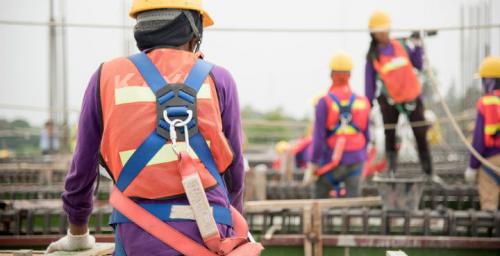Top 10 Safety Tips for Working at Height

It's safe to say that some sectors and occupations are more dangerous
than others. Safety hazards and unsafe working conditions can lead to illness,
injury, or even death, which is why every employer needs to take a step back
and determine how to eliminate potential risks. If your employees work at
heights almost every day, it's vital to stay focused on their safety and
provide equipment that will reduce the risk of falls and similar injuries.
In hazardous working environments, one mistake is more than enough to
put your employees at risk. That's why both employers and workers should learn
how to handle risks and prevent accidents in the workplace. Your job is to
recognize and remove potential hazards, but you also have to provide adequate
training and safety equipment. Here are the top 10 safety tips you need to
consider before you can allow your employees to work at heights.
Use railing
Protective barriers can be useful when your employees have to work on
roofs or in a similar working environment. The best thing about railings is
that they're a form of passive protection, which means that your workers only
have to stay within the rails to stay safe. Use rails whenever possible because
they're the cheapest form of protection. There are various types of barriers,
and even your carpenter can make them with discarded wood pallets.
Perform a job safety analysis
A job safety analysis can help you eliminate potential risks in your workplace. This procedure will help you
identify hazards and develop safety procedures that will allow your employees
to avoid life-threatening emergencies. A job safety analysis can prevent hazardous
conditions and improve your communication with employees, but it can also
enhance your health and safety culture.
Establish a plan
When dealing with safety hazards, it's vital to establish a plan that
has the potential to protect your workers. This plan can help you control all
risks and reduce injuries in your workplace. Before you allow your employees to
work, it's vital to plan and organize every aspect of their job because that's
one of the best ways to prevent injuries.
Inform your employees
Your employees must be familiar with safety precautions. Talk to them
about your hazard control plans and establish new rules and boundaries that
should minimize the risk of injuries. Your workers need to know how to perform
their job and stay safe at the same time.
Select the proper PPE
Every employee should wear and have access to personal safety
equipment. PPE can minimize exposure to hazards and help your workers reduce
workplace accidents. It's vital to do research and determine what you really
need before you invest in new equipment. Even if some types of PPE are
expensive, they can help you save lives and improve your safety standards.
Inspect your equipment before you allow your workers to use it
It's critical to inspect your equipment before you put it to use.
Follow the manufacturer's recommendations and learn how to store all equipment
properly. Inspection and maintenance are vital, but you also need to teach your
employees how to use and store their personal protection equipment.
Ensure proper use of lifts
Safe lifting operations are vital for your business. There are some
safety tips you need to consider before allowing your employees to operate
lifts. These safety tips can prevent damage and accidents. It's advisable to
hire trained lift operators and remember that every person working in a lift
must be properly tied-off.
Use ladders properly
Climbing a ladder at home is not the same as performing the same
activity at work. Teach your employees to use extension ladders because they
can be very dangerous. Ladders can be used for work at heights, but your
employees need to know that climbing ladders often leads to fatal accidents.
Invest in proper training
Work at heights training should be mandatory
because it teaches your employees how to handle the new equipment. It gives
your employees the opportunity to gain knowledge and experience before you
allow them to work at heights, but it also teaches them how to prevent falls
and minimize common workplace risks.
Establish a culture of safety
Establishing a health and safety culture can boost productivity in
the workplace and reduce hazards. Document everything and use that information
to discuss hazards, update your safety equipment and prevent risky behaviours
in the future. Developing a strong safety culture can improve organizational
performance, but it will also affect accident reduction.
Conclusion
Working at heights and feeling safe while performing your job
requires training and proper preparation. Make sure you provide training and
PPE for your employees and encourage them to discuss safety issues. It's
impossible to eliminate accidents in a hazardous workplace, but you have to do
your best to reduce them and make your employees feel safe.
Post Your Ad Here
Comments